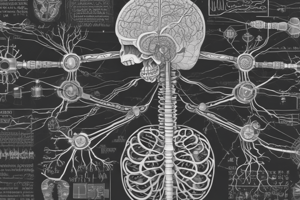Podcast
Questions and Answers
What is the primary function of the central nervous system (CNS)?
What is the primary function of the central nervous system (CNS)?
- To make voluntary actions automatic
- To facilitate sensory reception only
- To transmit nerve impulses to effectors
- To regulate bodily functions and activities (correct)
Which type of neuron is responsible for transmitting nerve impulses from the sense organs to the CNS?
Which type of neuron is responsible for transmitting nerve impulses from the sense organs to the CNS?
- Sensory neurone (correct)
- Relay neurone
- Interneuron
- Motor neurone
What type of action is primarily controlled by the spinal cord?
What type of action is primarily controlled by the spinal cord?
- Reflex actions (correct)
- Voluntary actions
- Involuntary actions
- Cognitive actions
What role do synapses play in the nervous system?
What role do synapses play in the nervous system?
Which of the following accurately describes the structure of a motor neurone?
Which of the following accurately describes the structure of a motor neurone?
How is a nerve impulse transmitted across a synapse?
How is a nerve impulse transmitted across a synapse?
In the context of nerve impulses, what do 'effectors' refer to?
In the context of nerve impulses, what do 'effectors' refer to?
What occurs when a stimulus is detected by the receptors?
What occurs when a stimulus is detected by the receptors?
What does the term 'involuntary actions' refer to in the context of the nervous system?
What does the term 'involuntary actions' refer to in the context of the nervous system?
What is the primary function of a motor neurone in reflex actions?
What is the primary function of a motor neurone in reflex actions?
Which type of reflex action is controlled by the spinal cord?
Which type of reflex action is controlled by the spinal cord?
What does the reflex arc represent?
What does the reflex arc represent?
In the case of touching a hot object, which neurones transmit signals to the spinal cord?
In the case of touching a hot object, which neurones transmit signals to the spinal cord?
What is a key difference between the nervous control and endocrine control systems?
What is a key difference between the nervous control and endocrine control systems?
Which example illustrates a cranial reflex?
Which example illustrates a cranial reflex?
Which statement accurately describes the nature of responses in nervous control?
Which statement accurately describes the nature of responses in nervous control?
Flashcards are hidden until you start studying
Study Notes
Sensitivity and Response
- Sensitivity refers to the ability of organisms to react to stimuli in the environment.
- A stimulus triggers a reaction known as a response.
Role of the Nervous System
- The human nervous system regulates bodily functions and interactions with the environment.
- Voluntary actions are consciously controlled; involuntary actions operate without conscious control (e.g., heartbeat, breathing).
Components of the Human Nervous System
- Central Nervous System (CNS) includes the brain and spinal cord.
- The spinal cord mainly handles automatic reflex actions.
- The brain processes sensory information from touch, smell, and taste.
- Peripheral Nervous System (PNS) comprises cranial and spinal nerves, as well as sensory organs.
- Sensory organs actuate nerve impulses in response to stimuli.
Neurones
- Nervous tissue comprises nerve cells called neurons.
- Each neuron consists of a cell body with a nucleus and nerve fibers (cytoplasmic strands).
- Sensory Neurone: Transmits impulses from sense organs to the CNS, featuring a circular cell body and a long nerve fiber.
- Relay Neurone: Relays impulses between sensory and motor neurons, typically located in the CNS with many short nerve fibers.
- Motor Neurone: Sends impulses from the CNS to effectors, characterized by an irregular-shaped cell body and a long nerve fiber.
Synapse
- A synapse is the junction between two neurons.
- Nerve impulse transmission across a synapse relies on chemicals, as impulses cannot cross directly.
- Painkillers can block these synaptic spaces, preventing the transmission of nerve impulses.
Nerve Impulse Pathways in the Spinal Cord
- Sensation: Involves sensory and relay neurons; the brain interprets nerve impulses for sensations (e.g., feeling temperature).
- Pathway: Receptor → Sensory Neurone → Relay Neurone → Brain.
- Voluntary Action: Involves relay and motor neurons; initiated by conscious decision (e.g., raising a hand).
- Pathway: Brain → Relay Neurone in spinal cord → Motor Neurone → Effector (muscle).
Reflex Action
- A reflex action is an automatic response to a stimulus without conscious thought.
- Types of reflexes:
- Cranial Reflexes: Controlled by the brain (e.g., blinking).
- Spinal Reflexes: Governed by the spinal cord (e.g., withdrawing hand from heat).
- Reflex Arc: The pathway for reflex actions, involving receptors, sensory neurons, relay neurons, motor neurons, and effectors.
Endocrine vs. Nervous Control
- Similarities: Both systems transmit messages to target organs in response to stimuli.
- Differences:
- Nervous control is localized; endocrine control can affect multiple organs via hormones.
- Nervous control elicits quick responses; endocrine responses are slower.
- Nervous responses can be voluntary, involuntary, short-lived; endocrine responses are usually involuntary and can be long-lived.
Studying That Suits You
Use AI to generate personalized quizzes and flashcards to suit your learning preferences.




